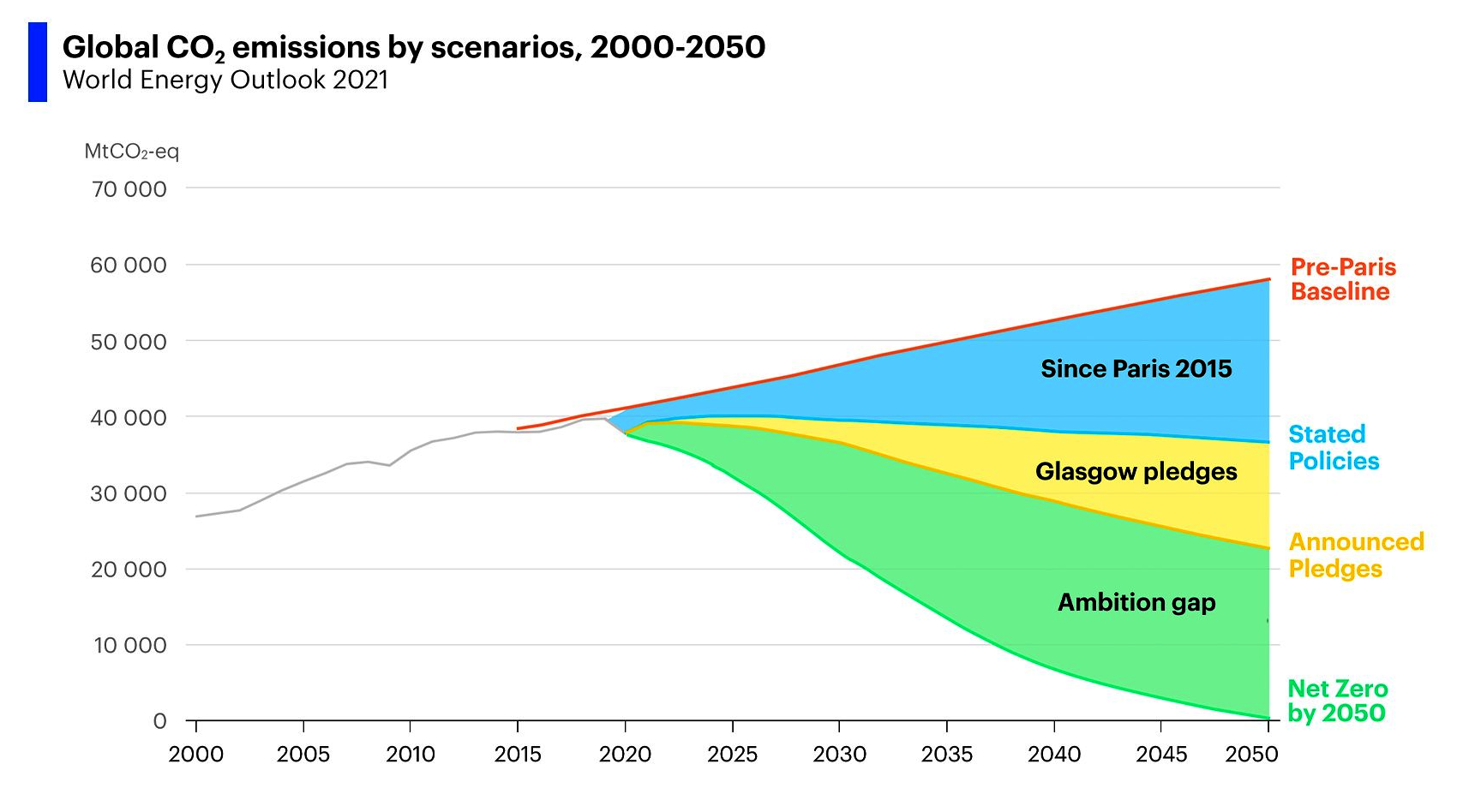Ahmedabad
(Head Office)Address : 506, 3rd EYE THREE (III), Opp. Induben Khakhrawala, Girish Cold Drink Cross Road, CG Road, Navrangpura, Ahmedabad, 380009.
Mobile : 8469231587 / 9586028957
Telephone : 079-40098991
E-mail: dics.upsc@gmail.com

World Energy Outlook 2021
News: Recently, the International Energy Agency (IEA) released the World Energy Outlook (WEO) Report 2021. Published every year, the WEO provides critical analysis and insights on trends in energy demand and supply. The 2021 report signaled pressure on governments to push for greater climate action at the Conference of Parties (COP26) summit (in Glasgow, UK).Earlier, IEA also released its Net Zero Emissions (NZE) Roadmap - named ‘Net Zero by 2050’.
Details:
• Renewable energy sources, such as solar, wind, hydropower and bioenergy, need to form a far bigger share in the rebound in energy investment after the coronavirus pandemic.World is not investing enough to meet future energy
needs, and the uncertainties are setting the stage for a volatile period ahead.
• Demand for renewables continues to grow. However, this clean energy progress is still far too slow to put global emissions into sustained decline towards net zero by 2050, which the IEA believes will help limit the increase in global temperatures to 1.5 degrees Celsius.
• Initially IEA supported continued investment in fossil fuels. However, it has gradually moved toward a “more distinct tone urging decision makers to mitigate climate change”.
• The extra investment might not be as difficult as it sounds. More than 40% of the required emissions reductions would come from measures that pay for themselves, such as:
• Improving efficiency,
• limiting gas leakage, or
• installing wind or solar in places where they are now the most competitive electricity generation
technologies.
• The IEA analyzed two possible scenarios:
• This looks at the measures and policies that governments have already put in place. Despite the measures, annual worldwide emissions would still be the same as developing countries build up their infrastructure.Under this scenario, temperatures in the year 2100 would be 2.6 C higher than pre industrial levels.
• This looks at governments’ pledges to achieve net-zero emissions, potentially doubling clean energy investment over the next decade.If countries manage to implement these pledges in time, the global average temperature increase would be around 2.1 C by the year 2100 — an improvement, but still well above the 1.5 Celsius agreed under the Paris accord.
India Specific Findings
• India will become the most populous nation surpassing China's population this decade, and by 2050 India crosses 1.6 billion in population whereas China's population is projected to decrease.
• India's GDP will be growing faster than China on average over the next three decades [5.3% vs China's 3.6%].
• In India, over 50 GW of Financially Stressed Coal Assets (NPAs) has created strains in the banking system.Coal demand in India is expected to grow by around 30% by 2030.
• As per their announced pledges, after China, India is projected to be the next largest user of unabated coal, responsible for about 15% of global use for electricity generation in 2030.
• A failure to accelerate clean energy transitions would continue to leave people exposed to air pollution globally.Recently 1.67 million premature deaths in India were linked to air pollution, that's more than three deaths every minute.
• Notable examples of developing economies mobilising capital for clean energy projects, such as India's success in financing a rapid expansion of solar photovoltaics (pv) in pursuit of its 450 GW target for renewables by 2030.
• Recent survey data from the World Health Organization for India revised the historic clean cooking access rates.This is due to faster progress than previously assumed, in large part due to the Pradhan Mantri Ujjwala Yojana LPG distribution scheme.
• Calls for India to mandate a default set point temperature of 24 degrees Celsius for all room air conditioners and tighter minimum performance standards with the aim to improve efficiencies as the demand for cooling and power increases.
Way forward:
• This requires a doubling of solar PV and wind deployment relative to the [announced pledges scenarios].
• A major expansion of other low-emissions generation, including the use of nuclear power where acceptable; a huge build-out of electricity infrastructure and all forms of system flexibility, including from hydropower; a rapid phase-out of coal; and a drive to expand electricity use for transport and heating.
• A relentless focus on energy efficiency, together with measures to temper energy service demand through materials efficiency and behavioral change.
• A drive to cut methane emissions from fossil fuel operations and a big boost to clean energy innovation.
• Making the 2020s the decade of massive clean energy deployment will require unambiguous direction from COP26.

Address : 506, 3rd EYE THREE (III), Opp. Induben Khakhrawala, Girish Cold Drink Cross Road, CG Road, Navrangpura, Ahmedabad, 380009.
Mobile : 8469231587 / 9586028957
Telephone : 079-40098991
E-mail: dics.upsc@gmail.com
Address: A-306, The Landmark, Urjanagar-1, Opp. Spicy Street, Kudasan – Por Road, Kudasan, Gandhinagar – 382421
Mobile : 9723832444 / 9723932444
E-mail: dics.gnagar@gmail.com
Address: 2nd Floor, 9 Shivali Society, L&T Circle, opp. Ratri Bazar, Karelibaugh, Vadodara, 390018
Mobile : 9725692037 / 9725692054
E-mail: dics.vadodara@gmail.com
Address: 403, Raj Victoria, Opp. Pal Walkway, Near Galaxy Circle, Pal, Surat-394510
Mobile : 8401031583 / 8401031587
E-mail: dics.surat@gmail.com
Address: 303,305 K 158 Complex Above Magson, Sindhubhavan Road Ahmedabad-380059
Mobile : 9974751177 / 8469231587
E-mail: dicssbr@gmail.com
Address: 57/17, 2nd Floor, Old Rajinder Nagar Market, Bada Bazaar Marg, Delhi-60
Mobile : 9104830862 / 9104830865
E-mail: dics.newdelhi@gmail.com